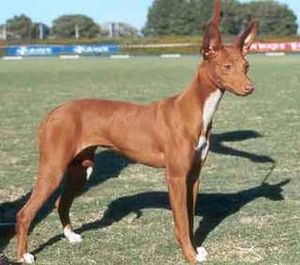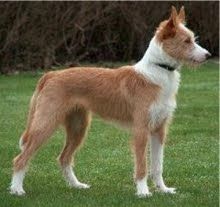Et oui, ça se complique chez le POD.....
Et oui, ça se complique chez le POD !
Et oui, ça se complique chez le POD.....
version Anglaise en bas de page
Afin de faire connaissance avec ces toutous, je vous ai fait un petit descriptif, simple et efficace, de chacune des races de Podencos.
Non, je ne vais pas vous donner les standards de la classification mais, juste quelques infos pratique pour comprendre le tempérament de votre podenco et, le pourquoi du comment de son caractère
Je commence par le seul podenco non reconnu par la FCI ( et c’est bien dommage car, il mérite vraiment SA place), le PODENCO ANDALOU :
C’ est un animal qui, par son odorat et son instinct très développé font de lui un redoutable chasseur. Sa grande agilité et son extraordinaire résistance caractérisent l’Andalou et, font de lui, un animal exceptionnellement doué pour la chasse !
C’est un chien bien noble, intelligent, sociable et qui est toujours en alerte !!
Très affectueux, docile et loyal avec le propriétaire, il interrompt cette relation en cas de punition injuste.
3 tailles différentes ( petit, moyen et grand) et 3 types de poils dans chaque taille
( Type dur et long ; Type soyeux et long ; Type ras, court et fin )
Les trois races qui vont suivre sont reconnues par la FCI.
Je vous présente le PODENCO PORTUGAIS :
C'est un chien que j'adore dans son petit gabarit. J'ai eu la chance d'en avoir un en accueil et il était extra par sa vivacité et son dynamisme :
C’est un chien de taille moyenne. Il est bien proportionné, possède une bonne structure osseuse et est bien musclé. Il est doté d'une grande vivacité et il est remarquablement intelligent.
Il est très vif et éveillé, peu exigeant et plutôt rustique.
Cette race est surtout répandue dans le nord du pays, où ces chiens sont utilisés conformément à leur aptitude naturelle à la chasse au lapin, soit en meute, soit isolément. C’est pourquoi ce chien est également connu sous le nom de chien de garenne. Dans Ces régions il sert également de chien de garde ( bin oui, il a de la gueule….lui ! )
3 tailles différentes : le petit ( 20 à 30 cm), le moyen ( 40 à 55 cm) et le grand ( 55 à 70 cm)
Voici l’élégant PODENCO CANARIO :
On l'emploie à la chasse au lapin, et, dans ce but, il s'adapte parfaitement aux multiples irrégularités du terrain en employant son flair prodigieux, sa vue et son ouïe.
Grâce à son flair et a son ouïe, il est capable de détecter la présence de lapins au fond des fentes naturelles du terrain, dans les lézardes des murs, dans les tas de cailloux en bordure des terres labourées, dans les tuyaux volcaniques et dans les buissons épineux. Sa survivance extraordinaire est sans doute due a ses dons de chasseur qui l'ont rendu irremplaçable tout au long des siècles. C'est principalement un chien pisteur qui ne doit ni aboyer ni attraper le gibier pendant son travail au flair.
C'est un chien de taille moyenne, longiligne, élancé, léger et extrêmement résistant. Le squelette est bien développé. L'absence de couche de graisse permet de discerner le gril costal, la colonne vertébrale et les os de la hanche. La musculature est développée au plus haut degré, sèche; les contractions des muscles sont visibles à travers la peau.
Le Canario est : Courageux, nerveux, agité et d'un dynamisme ardent, imposant, mais absolument pas agressif. Attaché avec abnégation a son maître, il supporte les journées les plus rigoureuses sans la moindre défaillance.
Et, je termine avec le grand PODENCO IBICENCO :
L' IBICENCO s’emploie surtout pour la chasse au lapin sans fusil, de jour comme de nuit. Il le fait facilement lever, même en des endroits à végétation abondante, grâce à la finesse de son odorat que, avec l’ouïe, il utilise plus que la vue. Par son agilité et son astuce, il capture rapidement le gibier. Ils sont également utilisés pour le lièvre et le gros gibier. Ce sont de bons rapporteurs.
Ces chiens furent probablement apportés dans ces îles par les Phéniciens, les Carthaginois et, éventuellement, par les Romains.
Il s’agit donc d’un type de chien primitif et rustique, une des plus anciennes races connues dont on peut voir la représentation dans les tombes de pharaons et sur des pièces de musées, ce qui en fait remonter l’origine à 3400 ans A.C.
L’Ibicenco est un chien qui préfère vivre en meute. Il peux s'adapter à d'autres races ou même à un chat, s'il pense que ces animaux, font partie de sa meute
Voilà ma présentation terminée et j'espère que vous y voyez plus clair maintenant !!
Ceci-dit, moi la première, j'ai beaucoup de difficulté à différencier le CANARIO de l'IBICENCO.
Et, j'ai une amie, éleveuse de Podencos et grande connaisseuse de ces races, qui m'a donné un truc, certes pas infaillible mais, qui marche bien....si je puis dire :
le Canario à les pattes avant façon " Louis XV"
Façon "Louis XV" me direz-vous, mais ça veut dire quoi ??
et bien, ça veut dire que le Canario place toujours ses pattes avant tournés vers l'extérieur, comme ceci :
Merci à Aire-Niño d'avoir si gentiment posé pour l'exemple !
And yes, things can seem a little complicated with the PODs .....
Here’s a short description, simple and concise of the various Podenco breeds which will help to acquaint you with these fascinating hounds
No, I’m not going to give you the standard classification details but rather some practical information to understand your Podenco’s temperament and character
I’ll begin with the only Podenco not recognized by the FCI (and that's a shame because he really deserves his place!), the ANDALUSIAN Podenco:
This hound is a formidable hunter thanks to his keen sense of smell and his highly developed hunting instincts. His agility and extraordinary resistance characterize the Andalusian and make him an exceptionally talented hunting companion!
He is a very noble dog, intelligent, sociable and is always in ‘hunting-mode’!
Very affectionate, obedient and loyal to his owner, he will however distance himself from his owner if brutalised and unjustly punished
There are 3 different builds (small, medium and large) and 3 coat types for each build: long-haired bristly, long-haired silky and short-haired smooth.
The following are the three races officially recognised by the FCI.
Firstly allow me to present the PORTUGUESE Podenco:
He’s an adorably lively and graceful hound. I was lucky enough to look after one for a short period and totally succumbed to his dynamic and vibrant charm:
He’s a medium sized dog, well proportioned with good bone structure and well muscled. He is extremely rapid and is remarkably intelligent.
Although he is very sharp and curious about everything, he is very undemanding and rather ‘countrified’.
This breed is especially prevalent in northern parts of the country, where these dogs are used for their natural ability to hunt rabbits, either in packs or individually. Therefore, this dog is commonly known as a ‘warren-dog’. In these regions he also serves as a guard dog (well sure, like everyone he has a mouth and he knows how to use it!!)
There are 3 different builds: small (20 to 30 cm), medium (40 to 55 cm) and large (55 to 70 cm)
Secondly let me tell you about the elegant CANARIES Podenco:
He is used to hunt rabbits, and as such hunts perfectly on rugged terrain thanks to his prodigious sense of smell and hearing and his extremely keen vision.
With his flair and hearing he is able to detect the presence of rabbits hidden in crevices, in cracks in the walls, under piles of stones, in volcanic tunnels and in thorny bushes. The extraordinary survival of this breed is probably due to it’s talents as a hunter which have rendered them invaluable throughout the centuries. He’s primarily a tracking dog who excels in snaring his prey noiselessly and without touching/damaging it.
This is a medium build hound, slender, elegant, lightweight and extremely hardy. He has a well developed bone structure. As he’s built for speed, so no fatty skin, his rib cage, spine and hip bones are clearly visible. The muscle framework, like that of a long distance runner, is at its maximum level so that even dry muscle contractions are visible through the skin.
The Canaries Podenco is: very brave, highly-strung, vivacious and dynamic, ever present at his master’s side – a fearless hunter but totally passive towards humans and ‘non-prey’ animals. Devotedly attached to his master, he will be with him through thick and thin!
Lastly but by no means leastly let me tell you about the marvellous IBIZAN/BALEARICS Podenco:
This hound is primarily used for hunting rabbits without arms, by day and by night. He easily stalks and forces the rabbits out, even in areas of dense vegetation, thanks to his finely honed senses of smell and hearing being a scent rather than a sight-hound. Because of his great agility and cunning, he quickly captures the game. Theses hounds are also used to hunt hare and other wild game as they can be dressed to be excellent retrievers.
These hounds were probably introduced to the Balearics by the Phoenicians, the Carthaginians and, perhaps even by the Romans. This is a natural, rustic dog, one of the oldest breeds known to man which one can see in the paintings to be found in the pharaohs tombs and ancient Egyptian artefacts dating back to 3400 years AC
The Ibizan hound is a pack dog rather than a solitary animal. He gets on well with other breeds and even with cats that are a part of the family once he realises that these animals are part of his own pack!
That’s the end of my presentation and I hope that things seem clearer to you now!
-That said, even I, a Pod-crazy person, have great difficulty in differentiating the CANARIES and the BALEARICS Podencos. So, to help you out, here’s a tip given to me by a friend -a PODENCOS breeder and a fine connoisseur of these noble hounds. It’s certainly not infallible, but it works most of the time:
The CANARIES Pod has "Louis XV" front legs. I can hear you all saying: "Louis XV", but what does that mean? Well, that means that the Canaries Pod always turns his front paws outwards, like this:
Thank you dear Aire-Niño to have so kindly posed for the photo!
One startling thing that may interest our Australian friends is that the Podenco is often called the ‘Kangaroo Hound’. Why – because this amazing dog can literally jump up to XX meters in the air and XX meters forward from a sitting/standing position, head pointed down all the while so as to spot his prey. Thus it goes without saying that you need some very high walls around your garden to keep him from jumping over them if ever he sniffs ‘something good’ and that you’ll have some astonishing photos/video footage to show your friends!!


/https%3A%2F%2Fprofilepics.canalblog.com%2Fprofilepics%2F5%2F9%2F591393.jpg)
/https%3A%2F%2Fstorage.canalblog.com%2F31%2F41%2F687264%2F79811909_o.jpg)
/https%3A%2F%2Fstorage.canalblog.com%2F63%2F21%2F687264%2F49329805_o.jpg)
/https%3A%2F%2Fstorage.canalblog.com%2F57%2F98%2F687264%2F47378484_o.jpg)
/https%3A%2F%2Fstorage.canalblog.com%2F69%2F13%2F687264%2F47377784_o.jpg)
/https%3A%2F%2Fstorage.canalblog.com%2F07%2F55%2F687264%2F47377548_o.jpg)










/https%3A%2F%2Fstorage.canalblog.com%2F98%2F86%2F687264%2F115589330_o.jpg)
/https%3A%2F%2Fstorage.canalblog.com%2F55%2F89%2F687264%2F114228441_o.jpg)
/https%3A%2F%2Fstorage.canalblog.com%2F17%2F28%2F687264%2F113855324_o.jpg)
/https%3A%2F%2Fstorage.canalblog.com%2F31%2F81%2F687264%2F112854075_o.jpg)